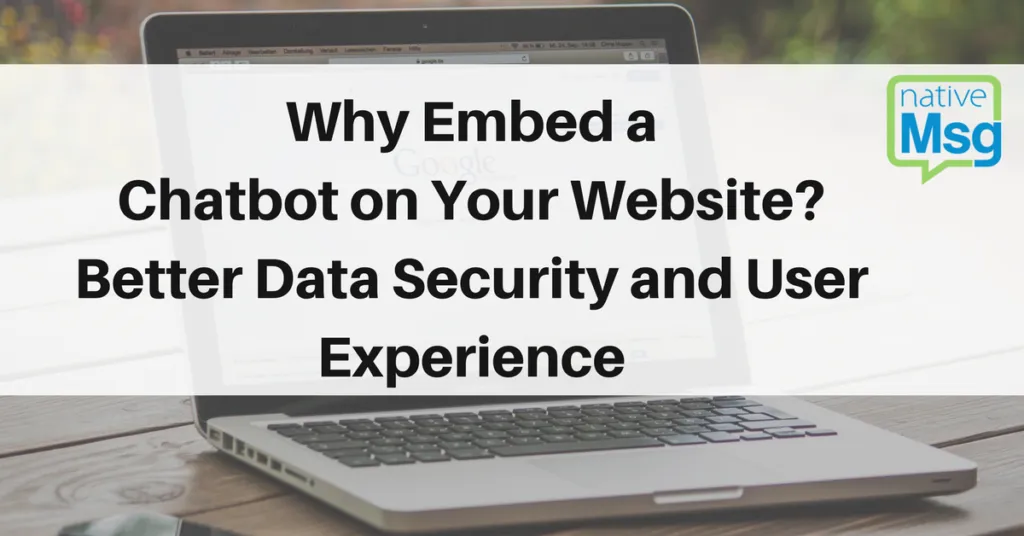
This is a follow-up post to the nativeMsg blog post: The State of Chatbots for Business on Facebook, Twitter and WhatsApp.
Last week, nativeMsg took a look at what’s happening on social media and where chatbot integration stands on WhatsApp. It’s a timely question as businesses decide how to move forward with third party chatbot integration on social sites and messaging apps. But what about a chatbot on website landing pages, or embedding a messaging chatbot on your business website? The benefits are plenty:
- Chatbots decrease bounce-rates.
- Chatbots bypass email marketing and create more informed user information.
- Chatbots increase a mobile-first strategy and user experience.
- Chatbots create better leads for a more informed hand-off to sales.
- Chatbots reduce acquisition costs with lightning speed information access.
While data shows that more and more consumers are willing and likely to engage with a chatbot, consumers are just as equally put-off by the security and lack of trust they have in social sites. According to one BBC report, a recent study shows only one in four users trust social media (and this number is more bleak, stateside, with just 9% of social media users who were "very confident" in social media data protection).
In addition, over 75% of businesses don’t have a cyber-security plan in place, though 90% have been compromised in some way. With the rise of chatbots comes the opportunity to firm-up security protocols and options.
Chatbot and Data Security 101

Chatbots are effective engagement managers, but data security is also a top priority.
The best way to secure data is to have clear and transparent oversight of it. That's critical now more than ever as a cloud-based digital world presents a need to better define your business security checkpoints, standards and methods.
People want a frictionless experience in tandem with the highest level of security. Chatbots are designed to ask questions and glean more personal information, so implementing conversational AI calls for even more clarity around data and security.
So by their very nature, chatbots are set to be one of the more robust data gathering tools. Likewise, intelligent chatbots, trained to work better the more you interact with them, can allow businesses to tailor messages, segment customers and respond with better products and service, but that also means security must be a priority.
Generally, data security entails assessing for threats and vulnerabilities.
User identity authentications, such as two-step verification or biometric authentication or tokens are some options for securing information. But when it comes to chatbot interactions, all of these of course create some amount of friction.
Instead, it's best for businesses to use end-to-end encryption messaging and seek a chatbot platform that supports messaging services that does so. WhatsApp users currently enjoy this security (though to date, chatbot integration isn't fully available) and iMessage does as well. Google’s RCS Messaging Services does not provide true end-to-end encryption, but encrypts messaging from user to user with Google as the intermediary. Google encrypts messaging (akin to their email protocol) in both transit and at rest.
Encryption to the Rescue?
But, it’s at the endpoints, not necessarily in transit, where data is more vulnerable and that is typically weakest at the end user. On-device encryption may be the answer, as well as educating users on upping personal security. These steps are important to consider for businesses today, to remain competitive digitally.
Cryptography that’s found in blockchain tech, particularly, may be a promising way to ensure onsite chatbot experience is well-secured down the line. While security breaches, like Bitcoin’s, have been in the news, encrypted micro-transactions, otherwise known as hash functions, built within the blockchain structure may be a more disruptive means to creating a frictionless, albeit data-secure environment.
The catch is that on-device technology support is the way forward. Additionally, blockchain mobile phones are still a way off and there's speculation that any models currently marketed really do provide the blockchain technology and security of M2M (mobile to mobile) security. So where does this leave businesses in terms of data security and chatbots?

Embedding messaging apps onto your site is one way to do that, which can be as simple as embedding an open-source tool onto your website. Businesses that build an onsite chatbot have significantly more control over security protocols and data storage methods. The easiest way to do so is to work with a chatbot platform and developer that supports multiple messaging channels as well as customizable solutions.
Embed a Chatbot Onsite for Better Engagement
There are a few ways to create an onsite chatbot. You can certainly link to a messaging app, or even create a site that is fully conversational.
Build from the Ground-up
Coding everything means you can customize every experience with your target audience and users in mind. Your team will most likely need to know Python or Java, two common languages for writing chatbots, as well as have machine learning savvy and experience. Though, the machine learning experience can be a tall order for many businesses.
Instead, a platform is an optimal way for enterprise and large corporations to begin with onsite chatbots.
Work with an NLP/NLU-Based Platform
A platform can negate the need for a steep machine learning experience curve, and you’ll work in tandem with the NLP platform features available to create the user experience, or flows. However, there’s more to this. You’ll also need a working understanding of a platform’s features to understand whether it’s the best fit for your chatbot goals and you may still need to code conversation flows as well as integrate the chatbot onsite.
Use a Simple Chatbot Builder
Small businesses can choose to use a simple interface chatbot builder platform or tool. Just like you might in building a website, these platforms allow you to bypass the need to understand coding, NLU, NLP or any machine learning and instead focus on the flows and the media you want to use. These can be placed on site and on any social channel your business uses.
That’s a good short-term solution for small businesses, but it still doesn’t allow for the breadth of customization and security control you need in the long run, nor is it the best fit for legacy, enterprise and corporate needs.
Still Want to Create on Social? The Right Platform Can Do It All
There are several ways to create a bot on Facebook, Twitter or Slack, for instance. You can use the step-by-step process offered online on Facebook, and numerous sites for Slack, to guide you through coding and integrating rich media to deploy a bot on your social channel.
You can then integrate the social site bot on your main website as an omnichannel feature there as well as across social channels, too. You can do that in a few creative ways:
- Write a Slackbot, one of the more accessible and user-friendly social channels to work in, and use a chatbot builder to embed a widget for it onsite.
- Again, with a Slackbot, find a service that uses a “Hook” (Facebook Messenger bots do this as well). The Hook will “call” or “enable” the bot to enter and interact on a channel - in this case - your website, and then interact with web visitors.
- And, find a service that uses REST API to more easily embed a Python or Java bot on site.
The good new is that you don’t have to look at these as separate options. Instead, a rich-featured platform with out-of-the-box features that include NLP and NLU can offer all these solutions as well as the ability to manage data more closely. It can also provide website plugins to work with all these channels.
What's Right for Your Business?
If you look at embedding an onsite chatbot similarly to building a website, you might already have your answer. Enterprise companies need comprehensive solutions.
The best route is to research the existing intelligent platforms available. You may ultimately forge forward building your own onsite chatbot from the ground-up, but the benefits of working with a solid API and rich-featured platform are many:
- An NLP-based platform can grow alongside tech advancement and the needs of your business.
- A platform can be customizable so that it integrates easily with your existing structure.
- Analytics and user experience can be set to the specific needs and goals of your brand.
- A platform that integrates NLP into conversational tools will train to provide better support over time for your specific users.
- Data security is easier to manage internally, as your IT team will be integral to integration and customization.
All this points to the need to keep security and chatbot development in equal stead. When you’re considering conversational AI for your business, it’s time to consider your long-term data security plan. The fact is, data breaches and hacking continue to deficit for any business or user. Working with an experienced team that encourages long-term restructuring to better prevent breaches makes sense. Combine this with a customized onsite chatbot that users trust and you’ll set the standard for digital security and experience.
Learn how a layer of conversational AI can be easily added to your digital platform with nativeMsg.

